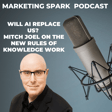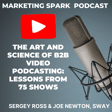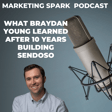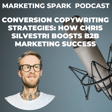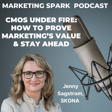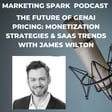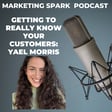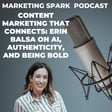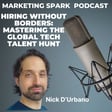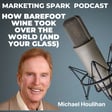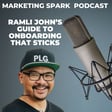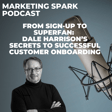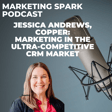Become a Creator today!Start creating today - Share your story with the world!
Start for free
00:00:00
00:00:01

FYI: Print Marketing is Not Dead.
Print is the Rodney Dangerfield of marketing; it gets no respect.
These days, it's all digital all the time. But print hasn't disappeared. It's still important and a key part of the marketing mix.
In this episode of Marketing Spark, Joanne Gore, an experienced B2B marketer, talks about how print and digital can form a beautiful marriage to drive marketing success.
To learn more about Joanne and why print still matters, visit the show notes.
Transcript
Introduction to Marketing Spark Podcast
00:00:04
Speaker
Hello, my name is Mark Evans, and I'd like to welcome you to Marketing Spark, the podcast that delivers small doses of insight, tools, and tips from marketers and entrepreneurs in the trenches. By small doses, it's conversations that are 15 minutes or less about marketers successes, failures, and what they've learned.
Is Print Marketing Still Relevant in the Digital Age?
00:00:23
Speaker
On today's show, we're going to talk about print.
00:00:26
Speaker
Yes, print. As much as everyone is obsessed with digital marketing, print is alive and well. And I'm excited to talk to Joanne Gore, a beauty marketer who's passionate about print. Joanne has spent the last three decades driving business with programs that generate awareness, customer engagement, and growth. Welcome to Marketing Spark. Hi, Mark. Thanks for having me. It's really a pleasure to connect with you and talk about one of my passions.
00:00:51
Speaker
As a former newspaper reporter, an ink stained newspaper reporter, I love print and for that matter paper. In a digital age, it's easy to forget about print. So my question to you is print still relevant? Does it still impact consumers and work
Beyond Newspapers: The Many Faces of Print Marketing
00:01:08
Speaker
for brands? The actual answer I would have to say is no. However, that's because print is not print as we know it. So let me explain.
00:01:21
Speaker
Imagine you walk into the, um, LCBO, uh, working on Canadian, the liquor control board or wherever you buy your alcohol. So when you walk in there, what do you see? Well, I see a magazine, I see bottles with printed labels on them. That to me is print. Right. What about the packages they're in? Are you seeing a difference now? And let's say the boxes that they come in today versus maybe what they came in 10 years ago. I'm not sure. Maybe you can explain that to me. Sure.
00:01:50
Speaker
So if you think about packaging today, a lot of it is all about go back to that unboxing experience from a
Creating Memorable Experiences with Print
00:01:58
Speaker
couple of years ago. Remember when there were like 60 million people were watching YouTube to watch people unbox things. It was the whole experience. And that's really, I think, where the packaging industry really started to take off when it comes to embellishment. These are the things like foil, those satin touches, those
00:02:17
Speaker
It almost looks like glitter and rhinestones and all these really, really cool things that you see in the beer store, in the wine store, in your grocery store, in almost any store. That whole experience, that touch, that feel, that memory, that is relevant and that is why print is relevant. But nobody thinks of it as print.
00:02:44
Speaker
When I think of print, I think of newspapers, magazines, books, you know, the kind of stuff that you touch and feel. But what you're saying is that print and copy for that matter is everywhere. It touches the products that we see, how we interact with products these days. Does it confuse people when we just say print? I think a lot of people still think of print as stationary, business cards, letterheads, and envelopes. And granted, business cards have a whole other life and genre of their own.
00:03:14
Speaker
But I just want to point out, because I know we're wrapped up for time and there's so many points I don't want to get across. Studies have shown that haptic touch, which is the memory, the touch memory, that's the type of memory that has the strongest impact on the human brain. So anytime you can take that digital experience, which again, can be all immersing, interactive, augmented reality, I get it. But when you layer on that
00:03:41
Speaker
touch to it. So imagine you're going through, you're buying something and then you get like a really custom piece of direct mail and I'm not talking about your standard letter. And again, it's the whole experience. Have you ever gotten a welcome kit after you've purchased a product or your new phone? Again, it goes back to that memory of
00:04:01
Speaker
that memory of, oh, it's going to stick with me. So if you're somebody who's considering a purchase and you are doing the digital journey that we all do, at some point in that journey, imagine if you got a piece of direct mail that tied you back to that experience you had, how much more valuable that would be. So I look at print as sort of a high value touch in the overall customer journey acquisition.
00:04:30
Speaker
It's interesting that you mentioned the idea of getting a note when you buy something. So for me, a recent example was I needed to get a microphone stand. So of course you order it on Amazon, the package arrives, the print on that box sort of sets the first impression. So you open the box and increasingly what you'll get as a note says, hope you enjoy our product. If you have feedback, here's where you can leave it. If you want to do a, if you want to share on social media. So I can see the interaction or the combination between online
00:05:00
Speaker
and print. What I'm wondering about is the role of print within an increasingly digital world. So people are consuming content and copy online. So has that forced print to change? Does print simply compliment digital in the real world? How do you see that relationship or the interaction between digital and print these
The Role of Print in a Digital World
00:05:24
Speaker
days? Again, to me, print is one tactic in your marketing arsenal.
00:05:31
Speaker
just like social media, just like direct mail, just like digital direct mail, just like pay-per-click, AdWords, you have a whole bunch of different marketing tactics. At the end of the day, and this is where I get on my little soapbox, the most important thing for any company is understanding who they help and how they help. And once you know who you're helping, then you can start to understand what messages and what content that they want to consume when they're trying to decide
00:06:00
Speaker
on what they're going to buy. Depending on what generation you are, you may want to watch sort of a longer video. If you're technically inclined, you may want to download a technical white paper. You might want to go on social media and engage on LinkedIn with the CEO of the company you're considering buying from because you want to know what this guy is all about. Through that all, there's the opportunity to elevate your engagement by making it hyper personal
00:06:30
Speaker
when you compliment your digital with print? It does, but what I find interesting is that this new generation of marketers, they have grown up digital and social media to them is the way that they communicate and interact. They don't think print first like you and I used to do. Like they're not, they probably don't read newspapers or magazines. Everything for them is digital. Everything is online.
00:06:56
Speaker
And so print may not be front and center for them. So when you're putting together a marketing strategy, do you think today's marketers downplay the importance of print or maybe not even appreciate the importance of print in the total mix? I think that that's what it is. And again, I think it goes back to what the perception is of print. As I think you are well aware that today's biggest consumer group in history
00:07:22
Speaker
is Gen Z and Millennials. They're gonna account for $4 billion in discretionary spending, like a ton of money. When surveys were done on college students, 92%, that's almost 100%, prefer reading print material to digital material. 78% of Millennials said that they enjoy the smell and feel of books and paper, and 58% said the same of magazine.
00:07:48
Speaker
The top 25 print magazines reached more adults and teens than the top 25 prime time shows. Think about, have you noticed a lot of these photo books now? You take all your digital images and now Facebook is saying, let's create a photo book for you. Let's create a permanent memory of your digital memories. This is all the world of print.
00:08:13
Speaker
Vistaprint has done a huge boom for print in many ways when you think about the promotional materials market. All of those logo packages, all your t-shirts, your hats, your pants, that's all print. It's just a different aspect of print. Yeah. And you get some major online brands that are actually producing print magazines these days. Exactly. And now the whole, so there's a new buzzword called fidgetle. Think about all the pop-up, those pop-up stores.
00:08:40
Speaker
So like Nike and Shopify, these huge brands are trying to bring a lot, and again, this is pre-COVID, of course, when we could do these things, but these pop-up stores rely so much on print. If you think about it, the look, the feel, the touch, everything that's in there, everything they sell, everything that has their brand, their logo, everything about them has now been turned into a real,
00:09:07
Speaker
touchable world that you can now go in and traverse. So how does today's marketer marry print and digital successfully?
Integrating Print and Digital for Customer Experiences
00:09:17
Speaker
What are the things they need to think about when they're putting together a marketing plan? And of course they want to use digital. I mean, they love digital. They understand digital as part of their everyday worlds, but how do they bring print into the mix effectively? The easiest way I can answer that is to say direct mail. And again, that takes on its own life.
00:09:36
Speaker
According to Canada Post, 4.4% success rate compared to emails, 0.12%. So that's in open rate and conversion rate. There's a lot going on. And again, Canada Post has done all of these neuroscience studies showing how the brain reacts to the written word, how it reacts digital versus print, direct mail, why they engage
00:10:03
Speaker
Tons of studies there as well. The bottom line goes back to who you help and how and what are your objectives and goals? Because you can throw anything to the wall, but the reality is how are you going to measure success? And are you trying to do brand awareness? Are you trying to generate leads? Are you looking for acquisition? What is the objective of your marketing program? And then you can decide what are the tools that I need to engage
00:10:31
Speaker
the right people that are gonna convert as quickly as possible, and more importantly, remember the experience and share it and become a great reference. That sounds like a very sound plan for marketing. So I can ask you one final question, because I promise people I wouldn't take more than 50 minutes of their time. Let's talk about measurement. Yeah. So the digital folks are unbelievably obsessed with the idea that everything can be measured
00:10:58
Speaker
So everything should be measured so they can drive, so they can optimize campaigns and drive ROI. How does that apply to print? How does that apply to a billboard or direct mail or an advertisement in a magazine?
Measuring Print's Impact in a Digital Strategy
00:11:11
Speaker
How can you align the print world with the always quantified digital world? How do you measure success?
00:11:20
Speaker
Yeah, exactly. How do you do that? How do you, what are the metrics for success? So again, it goes back to what your goal is. I mean, it's the same, you know, I get asked this question, how did, how about social media? How many leads am I going to get out of social media? When the expectation is leads and leads aren't necessarily always going to be the end result, then you are not marrying the right tactic to the right end result. So you have to understand its value. Its value is to continue,
00:11:47
Speaker
to engage and drive through the customer journey, whether it's before the sale, during the sale, or after the sale. Again, think welcome kits, client onboarding, one-year renewal statements, all of these things where you are touching and communicating with that end user using print. So think about all the people who produce statements and invoices and inserts and on-certs and cross promos and trans promos and everything else
00:12:15
Speaker
When you get your bill in the mail or even when it's presented to you online, how quickly is somebody going to pay that bill? Some is often tied to whether they receive a printed statement or a digital statement. Direct mail can be measured if you have personal URLs where you send everybody their own code, they can go to their own landing page. You know exactly how to measure that. So again, tying back your goals and
00:12:46
Speaker
complimenting your digital strategy with print will only help increase conversions, if that's what you're going after. If you're going after brand awareness, well, that's a whole other set of marketing tactics that I don't even think digital can measure. That's great, Joanne. Thanks for the insight. I know we don't have a lot of time and I'm sure you could go on for lots and lots of more time.
00:13:08
Speaker
Thanks for listening to another episode of Marketing Spark. If you enjoyed the conversation, please leave a review as well as subscribe via iTunes or your favorite podcast app. For show notes of today's conversation, visit markevans.ca. If you have questions, feedback, would like to suggest a guest, or are looking for help with B2B marketing, send an email to mark at markevans.ca. Talk to you next time.


